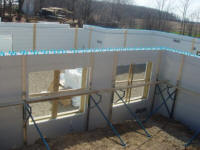|
Dear Partners,
The current economic crisis has some people questioning whether the
environmental/green advancements and plans we have made in the past
decade are still valid, or should be put on hold in order to concentrate
on and fix the economy first.
Others believe that the current crisis can only be solved by looking
at environmental goals at the same time. For example, if our cars and
homes were more efficient and used less energy, then energy prices would
not have the impact on our economy that they have had last year and
still do now. Another example is that the increased infrastructure
spending of our governments offers a great opportunity to achieve some
environmental goals at the same time: who would not insulate a school at
the same time as it is being renovated?
You can see that I am biased towards the group that thinks that
environmental goals actually can help us to get our economies out of
survival mode.
I just read an interesting article that fits right into this
thinking: In the last issue of Scientific American there is a short
article that talks about the environmental impact of crossties for
railroads. You might now wonder what does that have to do with you? A
lot, I think, because this argument is also one between wood and
concrete. Someone has calculated "that making enough concrete ties to
keep one kilometer of tracks aligned for 100 years generates the
equivalent of 656 to 1,312 tons of CO2. That amount is about one-half to
one-sixth the amount that timber ties contribute, because concrete
versions last longer and timber releases CO2 as it decays."
So if we assume that a minimum of 600 tons of CO2 are saved per
kilometer of track, then we could potentially save in the USA alone
(170,000 miles of track) more than 160 million tons of CO2 over the next
100 years, if we switched them all to concrete (assuming that they are
all wood now). That is more than Argentina's total annual CO2 emissions!
You can see that even such a small change could create much needed
construction work right now, and at the same time significantly reduce
our environmental footprint over decades.
The same concept applies to what we all aspire to do: replace wood
framing as the leading residential building method with concrete
construction, for healthier, more durable and environmentally friendlier
homes.
Best regards,
Hubert Max
Technical Questions That Expose the Competition
|
Many of you have sat through my presentation of "Uncovering The
Hidden Costs: Some Questions To Ask The Competition", which lists many
of the questions that our competitors have a hard time answering. Since
their solutions are often not well thought out or are non-existent, the
customer usually ends up spending far more money than they had
anticipated, even though they bought the "cheaper" product. Richard
DeVito from Innovative Building Products in Pompton Plains, New Jersey
recently took a sale back from "Brand X" block by asking these very same
questions.
Rich drove to meet with a prospective client on a large custom home
who had narrowed his choice of ICFs down to "X" block and Quad-Lock. In
the room were the general contractor, the architect, the project
manager, and the building owner. They had all sat through the
competitor's presentation some days earlier, and had all but made the
decision to buy "X". The atmosphere was polite, but cool. Rich was well
prepared. He set up his samples and the discussion began to flow.
Having reviewed his copy of the Quad-Lock C.A.S.E (Constructability,
Adaptability, Site Management, Efficiencies) binder, Rich knew the right
questions to ask and could demonstrate how our product would better
solve problems than the competition. He even had a custom PowerPoint
presentation prepared, which outlined all of his points. Let's look at
just a few excerpts from that conversation:
 Rich: "How do you plan to form your
door and window buck-outs?" The GC replied that the recommendation
from "X" was to use 2" x 12" pressure treated lumber to span across the
whole width of the walls. Rich then asked if they realized that this
would create a thermal bridge around each and every opening, negatively
off-setting the R-value of the ICF shell that the client chose
specifically for its energy efficiency. Rich then demonstrated that
smaller (therefore, less expensive) lumber could be used INSIDE the
Quad-Lock cavity, thereby preserving the continuous insulation envelope.
It immediately became clear that "X"s
advice came ONLY because they couldn't fit dimensioned lumber inside
their cavity due to plastic ties blocking the way. Rich: "How do you plan to form your
door and window buck-outs?" The GC replied that the recommendation
from "X" was to use 2" x 12" pressure treated lumber to span across the
whole width of the walls. Rich then asked if they realized that this
would create a thermal bridge around each and every opening, negatively
off-setting the R-value of the ICF shell that the client chose
specifically for its energy efficiency. Rich then demonstrated that
smaller (therefore, less expensive) lumber could be used INSIDE the
Quad-Lock cavity, thereby preserving the continuous insulation envelope.
It immediately became clear that "X"s
advice came ONLY because they couldn't fit dimensioned lumber inside
their cavity due to plastic ties blocking the way.
 Rich: "There are a lot of corners and
angles on this plan. How did the other guys suggest that you build all
of these?" Of course, pre-formed 90 and 45 degree blocks were cited
as the answer. Rich asked if these needed to be secured somehow, knowing
that the answer would be extra long zip ties, spray foam, and bracing on
the outside of the wall. When Rich brought out our 90 degree and angle
corner brackets, all eyes were fixed on him as he explained that 90s,
and in fact EVERY degree of angle, could be fashioned by using these
simple accessories along with the other 3 common Quad-Lock components.
When Rich made clear that there was no need to tie blocks together or
work on the outside of the building to support corners, there was no
further need for discussion. Rich: "There are a lot of corners and
angles on this plan. How did the other guys suggest that you build all
of these?" Of course, pre-formed 90 and 45 degree blocks were cited
as the answer. Rich asked if these needed to be secured somehow, knowing
that the answer would be extra long zip ties, spray foam, and bracing on
the outside of the wall. When Rich brought out our 90 degree and angle
corner brackets, all eyes were fixed on him as he explained that 90s,
and in fact EVERY degree of angle, could be fashioned by using these
simple accessories along with the other 3 common Quad-Lock components.
When Rich made clear that there was no need to tie blocks together or
work on the outside of the building to support corners, there was no
further need for discussion.
 Rich: "How is the site for storage?"
The GC said that space on the site was critical, and logistics could end
up being a nightmare. Rich explained that our panels would all be
delivered in flat packs, effectively cutting the storage space required
in half for product delivered to the site. By that time, all Rich could
see were nods of approval. Rich: "How is the site for storage?"
The GC said that space on the site was critical, and logistics could end
up being a nightmare. Rich explained that our panels would all be
delivered in flat packs, effectively cutting the storage space required
in half for product delivered to the site. By that time, all Rich could
see were nods of approval.
My point is this: Every aspect of Quad-Lock's design has been
considered from the point of view of solving building issues on the job
site. None of our competitors have put this degree of thought into the
actual process of building with their systems. Many have gotten little
further than containing concrete between two pieces of EPS. It is
surprisingly easy to uncover weaknesses by simply asking the right
questions, mostly about how the competitors intend to solve various
issues in building. The Training and Technical Services Department has
done a detailed study of every major competitor in the marketplace, and
has fashioned an easy-to-use, side-by-side comparative guide for use by
salespeople (the C.A.S.E. Binder).
Rich DeVito is an example of the professional salesperson who
researches his product and the competition, knows the questions to ask,
and knows that the answers will be in his favor.
Douglas Bennion
Training and Technical Services Department
Proven Energy Efficiencies
 As
part of our on-going development of materials to assist in the sale of
Quad-Lock, we want to create a library of statistics about structures
built with Quad-Lock Insulating Concrete Forms. You can help us by
submitting your energy bills, along with the bills from a comparable
house in your neighborhood for us to add to our library. When you do
this Quad-Lock will pay your highest month's
energy bill for your troubles. As
part of our on-going development of materials to assist in the sale of
Quad-Lock, we want to create a library of statistics about structures
built with Quad-Lock Insulating Concrete Forms. You can help us by
submitting your energy bills, along with the bills from a comparable
house in your neighborhood for us to add to our library. When you do
this Quad-Lock will pay your highest month's
energy bill for your troubles.
Contact us for more information.
|
